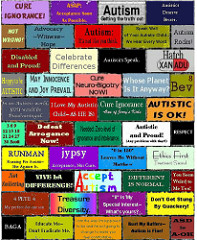When reading about various “cures” for autism, AD/HD et cetera, you’ll see the term “recovered” used. As in, “was ill but recovered”. This takes the medical model of disability rather far, from the sort of issue that may sometimes be addressed symptomatically using medical intervention (e.g. Ritalin for AD/HD), into the realm of a disease or pathology that must be cured using medical intervention.
“Recovered” can also mean “was lost but has been found”, which is not a coincidental usage when parents describe their child who was devastated by autism (slight projection there — I think it’s rather the parents who are devastated), and is otherwise doomed to be trapped in the dark abyss of autism. (I am not making up these catastrophic phrases; you can google them yourself.) And of course there’s the old cliché, “lost in your own little world”, which I heard repeatedly through my own childhood. (How silly — I mean, who else’s world would I be in?) Parents feel that when they try any number of cures and as the child matures and engages in less obviously-autistic mannerisms, that the child has been cured. (Hint: flapping less just means flapping less, or flapping less often in public; it doesn’t mean no longer autistic.)
When I hear the word “recovered”, my interest in architecture and design also brings to mind an image of period furniture that has been restored and re-covered, or of redecorating a room with coördinating damask or toile furniture upholstery and window dressing.
Therefore, I present to you the “recovered” autistic, delightfully upholstered in heavily-starched chintz figured with a botanical print of large flowers, including restoring the cushioning with extra padding in the bustier to compensate for the post-weaning boob deflation*.
The window-dressing effect of all that floral chintz was enhanced by the fact that there were several of us stiffly draped in identical yardage, formally lined up near the bride. This bridesmaid did not flap, but was prone to swaying and/or staring off into space more and more as the day and evening wore on.
Neatly recovered, but still as autistic as ever.

(Picture description: a black and white photograph of a bride’s maid wearing a princess-cut gown with short pouf sleeves, in a chintz fabric of large flowers and leaves. She is holding a long-stem bouquet, and the photograph has been cropped to only show her from neck to hips, and only part of the bride’s arm is visible.
* I knew I’d find a use for those discarded shoulder pads cluttering up my dresser drawer.








mumkeepingsane said,
24 June 2007 at 15:52
I’d love to find a way to replace “recovery” with, I don’t know, “growing up”? It seems to me as my son grows, learns, and changes he’s just doing what all his peers are doing…maturing. I don’t want him to be upholstered.
The dress is a bit girly for me. It looks a bit like curtains my mom had when I was a kid.
qw88nb88 said,
24 June 2007 at 13:36
Joe, the dress is two sizes too large, and I never voluntarily wear things with giant flowers, much less pink. As bridesmaid dresses go, it wasn’t bad. According to the newspaper, the trend nowadays is for women to get all dressed up in old bridesmaid dresses to dine out and (most humorously) then tour garage/jumble sales.
Estee, I believe that’s true to a large degree. It’s more about style over substance, and about keeping up appearances … I’m sure that Hyacinth Bucket would approve!
Estee said,
24 June 2007 at 11:27
I like this discussion on so-called “recovery” and upholstery. Are we just trying to re-cover autistic individuals with appropriate behaviour?
Club 166 said,
24 June 2007 at 6:11
I’ve seen lots worse bridesmaid’s dresses than that. I can see you actually wearing that again (to a summer outdoor party).
Joe